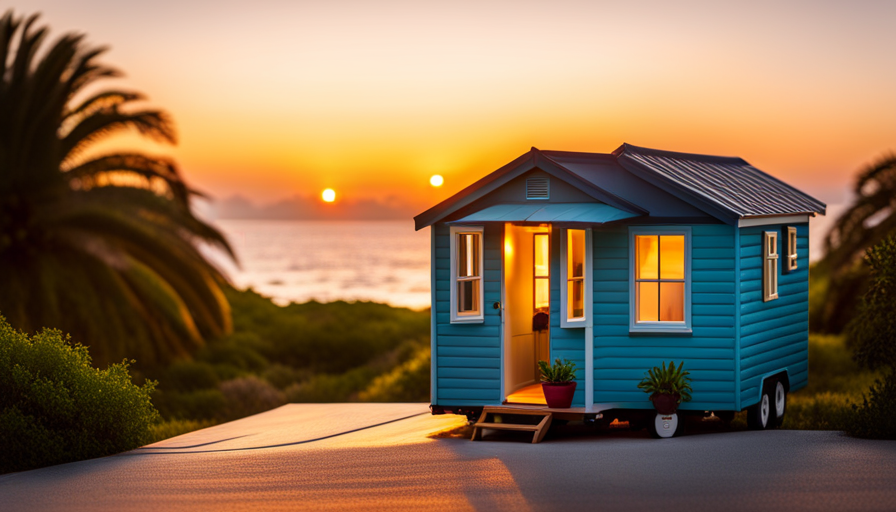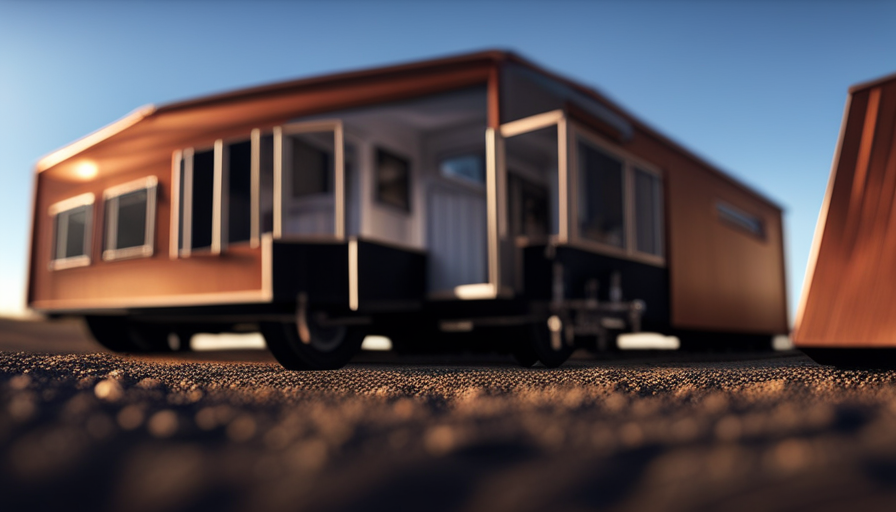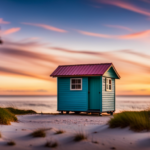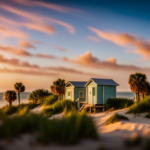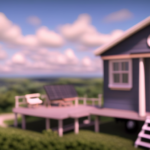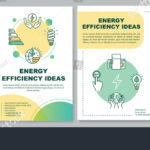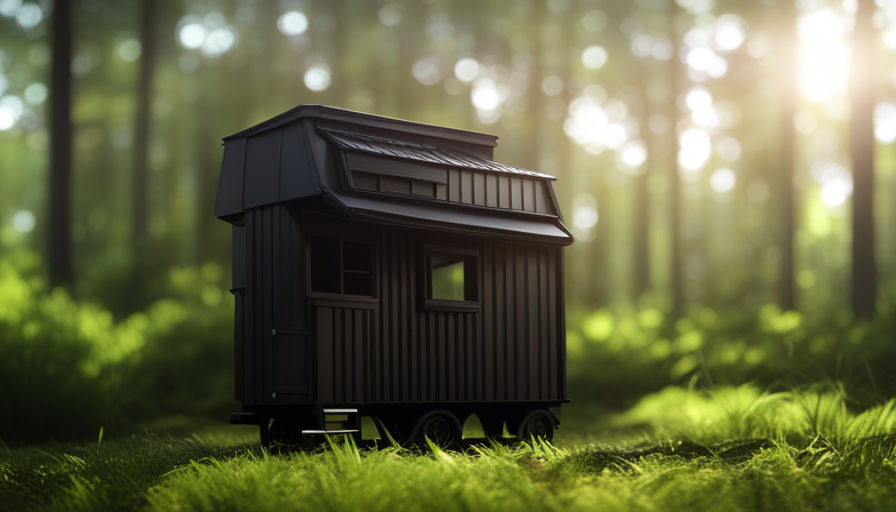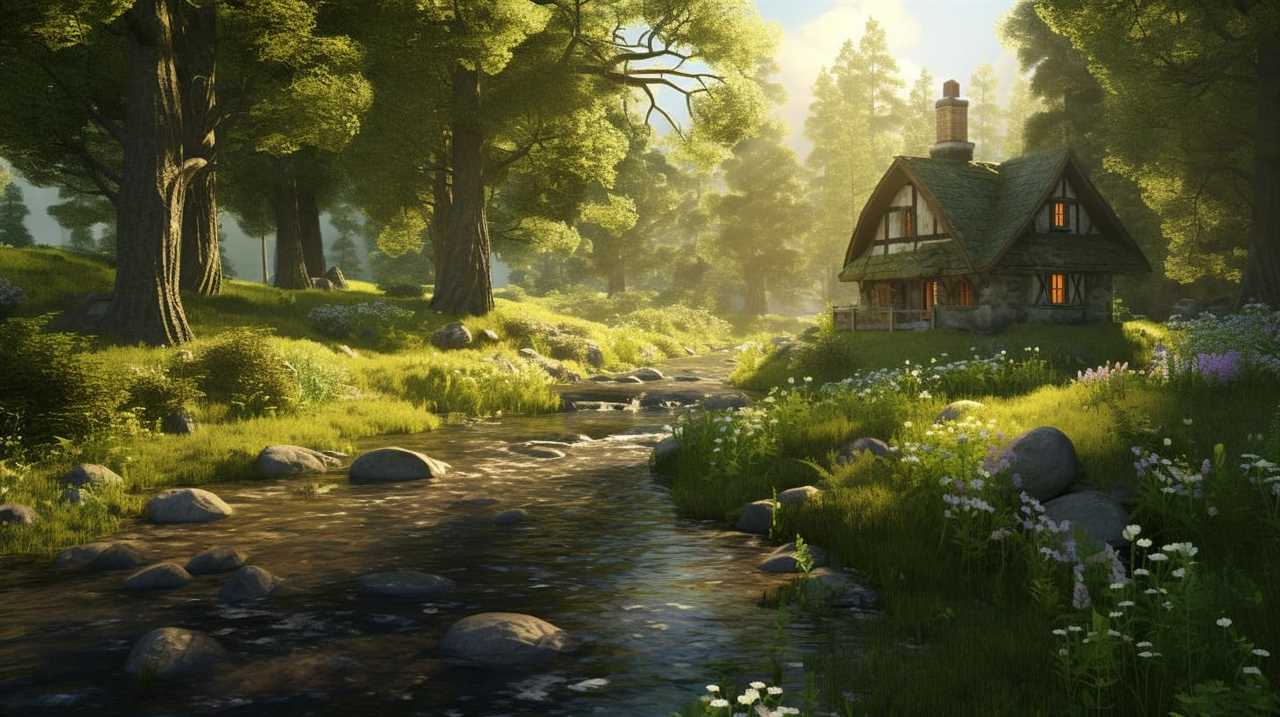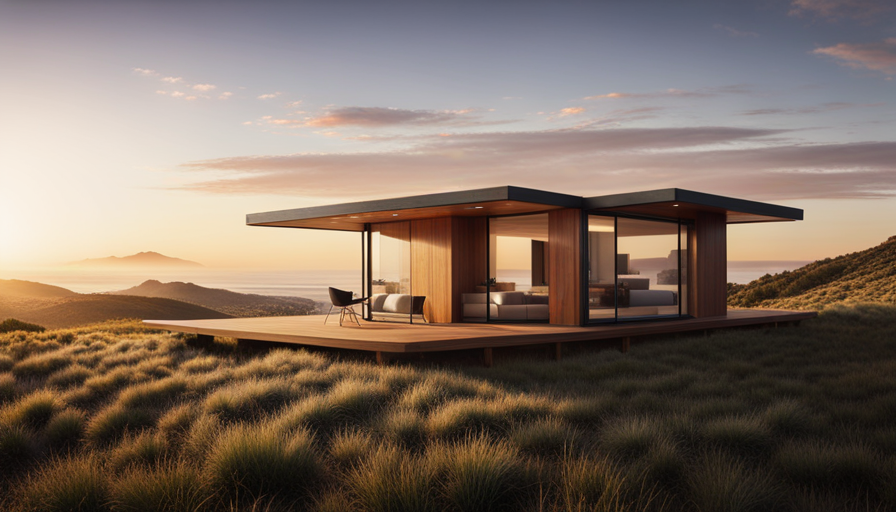How much does a tiny home in Florida cost? This is the key question for anyone interested in joining the Tiny House Movement in Florida.
As a tiny house enthusiast myself, I’ve delved into the world of tiny house prices in Florida to provide you with an objective, data-driven analysis.
In this article, we’ll explore the factors that affect the cost of tiny houses in Florida, the average prices you can expect to pay, and hidden costs you should consider.
We’ll also discuss financing options and the pros and cons of tiny house living in Florida. And if you’re in need of inspiration, we’ll showcase some amazing tiny house designs and communities in the state.
So, let’s dive into the world of tiny houses in Florida and find out how much your dream home may cost!
Key Takeaways
- Tiny houses in Florida range in price from $40,000 to $100,000, with pre-built options typically starting at $50,000 and DIY options starting at $20,000.
- Factors such as location, size, design, materials, customization, land cost, permits, and labor costs can affect the price of a tiny house in Florida.
- Hidden costs, such as utilities, off-grid systems, permits, zoning regulations, and maintenance, should be considered when budgeting for a tiny house in Florida.
- It is crucial to understand and adhere to building permits, zoning restrictions, and building codes to prevent legal issues when building or living in a tiny house in Florida.
Understanding the Tiny House Movement
The Tiny House Movement is all about embracing minimalism and finding creative solutions for living spaces. It has gained popularity in recent years as people are increasingly drawn to the benefits of living in a tiny house.
One of the main advantages of tiny houses is their affordability. With a smaller footprint, these homes typically cost less to build and maintain compared to traditional houses. They also offer the opportunity to live a more minimalist lifestyle, as they require downsizing and getting rid of unnecessary possessions. This can lead to a simpler and more clutter-free living environment, which many people find appealing.
In addition to the financial benefits, tiny houses also promote sustainable living. Due to their smaller size, they require fewer resources to build and operate. They have a smaller environmental footprint and can be more energy-efficient, which is a significant advantage in today’s world.
Moreover, tiny houses encourage a sense of community and connection. Many tiny house communities have started popping up across the country, where like-minded individuals can come together and support each other in their tiny house journey.
Understanding the benefits and appeal of the Tiny House Movement sets the stage for exploring the factors that affect tiny house prices in Florida.
Factors Affecting Tiny House Prices in Florida
Explore the various factors that impact the price you can expect to pay for your dream compact home in the sunny state of Florida. When it comes to tiny house prices in Florida, several factors come into play.
The location of the tiny house is one crucial factor affecting its price. In prime areas such as Miami or Key West, where demand is high, prices tend to be higher compared to more rural areas.
Another factor is the size and design of the tiny house. A larger and more intricate design will likely cost more. Additionally, the materials used and the level of customization can significantly impact the price. For example, high-end finishes and appliances will drive up the cost.
Other factors to consider are the cost of land, permits, and utilities. It’s also important to note that labor costs can vary depending on the builder you choose.
When building a tiny house in Florida, it’s essential to do thorough research, compare prices, and consult with experts to ensure you make informed decisions. Understanding these factors and following these tips will help you navigate the complex world of tiny house pricing in Florida.
Transitioning to the next section, let’s now explore the average costs of tiny houses in Florida.
Average Costs of Tiny Houses in Florida
When it comes to the average costs of tiny houses in Florida, it’s important to consider the options of pre-built versus DIY.
Pre-built tiny houses tend to have higher price ranges due to the convenience and time saved in the construction process. On the other hand, DIY options offer a more affordable alternative for those willing to put in the time and effort to build their own tiny house.
Additionally, the price ranges for different types of tiny houses can vary greatly depending on factors such as size, materials used, and amenities included.
Pre-built vs. DIY Options
If you’re looking to save some money, you might want to consider building your own tiny house in Florida instead of purchasing a pre-built one.
There are several advantages to the DIY approach. First, it allows for customization according to your specific needs and preferences. You can design the layout and choose the materials that fit your budget and style. Additionally, building your own tiny house can be a rewarding and fulfilling experience. However, it’s important to note that the DIY route requires time, energy, and a certain level of expertise.
If you’re not up for the challenge, there are financing options available for pre-built tiny houses in Florida. These options can make the purchase more affordable and accessible.
Moving on to the next section about price ranges for different types of tiny houses, it’s important to consider the various factors that influence costs.
Price Ranges for Different Types of Tiny Houses
One can expect varying price ranges for different types of tiny houses, taking into account factors that influence costs.
The average prices of pre-built tiny houses in Florida typically range from $50,000 to $100,000, depending on the size, materials used, and level of customization. DIY options, on the other hand, can be more cost-effective, with prices starting as low as $20,000.
Customization options such as high-end finishes, solar panels, or off-grid capabilities can significantly increase the overall cost. It’s important to carefully consider these customization options and their impact on the final price.
When comparing prices, it’s essential to keep in mind that additional expenses such as land purchase, permits, and utility connections are not always included. These hidden costs can add up quickly, so thorough research and planning are crucial.
Moving on to the subsequent section about hidden costs to consider, it’s important to be aware of these potential expenses in order to make an informed decision.
Hidden Costs to Consider
When considering the hidden costs of owning a tiny house in Florida, there are three key points to keep in mind: utilities and off-grid systems, permits and zoning regulations, and maintenance and upkeep.
Firstly, utilities and off-grid systems can add significant expenses to your monthly budget. You may need to invest in solar panels or other alternative energy sources.
Secondly, navigating the permits and zoning regulations in Florida can be a complex and time-consuming process. This can potentially result in additional costs for legal fees or modifications to your tiny house.
Lastly, maintaining and keeping up with a tiny house requires ongoing expenses for repairs, upgrades, and general upkeep. These costs should be factored into your overall budget.
Utilities and Off-grid Systems
Although it may seem counterintuitive, living in a tiny house in Florida can actually save you a ton of money on utilities and off-grid systems.
With the rising popularity of off-grid living and sustainable housing, many tiny house owners in Florida are taking advantage of renewable energy sources such as solar panels and wind turbines. These systems provide a cost-effective and environmentally friendly way to power their homes.
Additionally, tiny houses are designed to be highly energy-efficient, using less energy for heating, cooling, and lighting compared to traditional homes. This translates into lower utility bills and less reliance on the grid.
By embracing off-grid systems and sustainable practices, tiny house owners in Florida can not only reduce their ecological footprint but also save money in the long run.
Moving forward, it’s important to consider the permits and zoning regulations that come with building and living in a tiny house in Florida.
Permits and Zoning Regulations
To ensure a smooth and hassle-free experience, you need to familiarize yourself with the permits and zoning regulations in place for living in a compact home in the Sunshine State.
When it comes to obtaining permits for a tiny house in Florida, the process can vary depending on the specific location. However, there are some general steps that you may need to follow. These include submitting a detailed plan of your tiny house, obtaining a building permit, and complying with all safety codes and regulations.
Additionally, it’s essential to be aware of the zoning restrictions that may apply to your tiny house. Some areas may have specific zoning regulations that dictate where you can park or place your tiny house.
By understanding and adhering to these permits and zoning regulations, you can avoid potential legal issues and enjoy your tiny house living experience in Florida.
Now, let’s delve into the next section about maintenance and upkeep.
Maintenance and Upkeep
Take care of your compact home by regularly maintaining and keeping up with its upkeep requirements in order to ensure its longevity and optimal functionality.
Maintenance costs for a tiny house in Florida can vary depending on factors such as the size of the house, materials used, and specific features. However, on average, homeowners can expect to spend around $500 to $1,000 per year on maintenance expenses. This includes routine tasks such as cleaning, painting, and repairing any wear and tear.
It’s also important to consider long-term sustainability when maintaining a tiny house. This can involve implementing energy-efficient measures, such as installing solar panels or using recycled materials for renovations. By prioritizing regular maintenance and considering sustainable options, homeowners can maximize the lifespan of their tiny house and minimize future expenses.
When it comes to financing options for tiny houses in Florida…
Financing Options for Tiny Houses in Florida
Looking to finance a tiny house in Florida? There are various options available to help you turn your dream into a reality!
When it comes to tiny house financing, there are several loan options that you can consider. One popular choice is getting a personal loan from a bank or credit union. These loans can be used for various purposes, including financing a tiny house.
Another option is to explore RV loans, as many tiny houses are built on trailers and can be classified as recreational vehicles. RV loans often have competitive interest rates and flexible repayment terms.
Additionally, some tiny house builders offer in-house financing, allowing you to make payments directly to them over a set period of time. This can be a convenient option if you have a good relationship with a specific builder.
It’s important to carefully consider your financial situation and preferences before choosing a financing option that suits your needs. With the right financing in place, you’ll be one step closer to finding and purchasing your ideal tiny house in Florida.
Finding and Purchasing a Tiny House in Florida
Nestled amongst the palm trees and glistening waters of the Sunshine State, lies a hidden gem waiting to be discovered: the perfect tiny abode for your dreams.
When it comes to finding and purchasing a tiny house in Florida, there are a few key factors to consider.
Firstly, it’s important to research and connect with reputable tiny house builders in the area. These builders specialize in constructing compact and efficient homes, ensuring that every inch of space is utilized effectively. They can help you customize your tiny house to meet your specific needs and preferences.
Secondly, exploring your financing options is crucial. While some individuals choose to pay for their tiny house upfront, others may require financing assistance. Many financial institutions now offer specialized loans for tiny house purchases, making it easier to secure the funds needed to make your dream a reality.
In terms of financing, it’s important to consider factors such as interest rates, loan terms, and eligibility requirements. Comparing different lenders and their offerings can help you find the best fit for your financial situation.
As you consider these factors, it’s important to keep in mind the unique considerations for living in a tiny house in Florida.
Considerations for Living in a Tiny House in Florida
When considering living in a tiny house in Florida, there are two key points to take into account: lifestyle and space requirements, and legal and regulatory considerations.
It is important to assess if the tiny house lifestyle aligns with one’s personal preferences and needs, such as the ability to downsize and live a simpler life.
Additionally, understanding the legal and regulatory landscape surrounding tiny houses in Florida is crucial, as zoning laws, building codes, and permits may vary depending on the location.
Lifestyle and Space Requirements
To fully embrace the lifestyle and meet your space requirements, you’ll need to consider how much a tiny house in Florida costs. Living in a tiny house offers various lifestyle benefits, such as reduced maintenance, lower utility bills, and the opportunity to live a more environmentally conscious life. Additionally, the compact size of a tiny house encourages a minimalist approach to possessions, which can lead to a simpler and more fulfilling lifestyle.
Maximizing space is a crucial aspect of tiny house living. Clever storage solutions, multi-functional furniture, and efficient use of vertical space are essential for creating a comfortable living environment.
When it comes to the cost of a tiny house in Florida, prices can vary depending on factors such as size, materials used, and location. On average, you can expect to spend between $40,000 and $100,000 for a well-built, fully-functional tiny house. However, it’s important to note that these estimates are just a starting point, and additional costs may arise for customization, land purchase, or permits.
Considering these factors will help you make an informed decision about whether a tiny house lifestyle is right for you.
Moving on to the legal and regulatory considerations…
Legal and Regulatory Considerations
Navigating the legal and regulatory landscape can feel like traversing a labyrinthine maze, with permits, zoning restrictions, and building codes forming a complex web of rules and regulations. When it comes to tiny houses in Florida, there are specific permits and regulations that need to be considered. These include obtaining a building permit, ensuring compliance with local zoning restrictions, and adhering to building codes. Failure to obtain the necessary permits or comply with regulations can result in fines and legal complications. Additionally, hidden costs such as impact fees, utility connections, and sewage requirements should be taken into account. To help visualize the complexities of these regulations, here is a table outlining some of the key considerations:
| Permits and Regulations | Hidden Costs |
|---|---|
| Building Permit | Impact Fees |
| Zoning Restrictions | Utility Connections |
| Building Codes | Sewage Requirements |
Understanding and managing these permits and regulations, as well as the associated hidden costs, is crucial for anyone considering a tiny house in Florida. Transitioning into the next section, let’s explore the pros and cons of tiny house living in Florida.
Pros and Cons of Tiny House Living in Florida
Living in a tiny house in Florida offers both advantages and disadvantages. When considering the pros and cons of tiny house living in Florida, it’s important to weigh the benefits against the challenges.
On the positive side, one of the major advantages of living in a tiny house in Florida is the affordability. With the high cost of traditional homes in the state, tiny houses provide a more affordable housing option. Additionally, tiny houses are environmentally friendly and promote a minimalist lifestyle, reducing carbon footprint and encouraging sustainable living.
On the other hand, there are challenges to consider. Limited space can be a drawback, especially for those who are accustomed to larger homes. Additionally, zoning regulations and building codes can pose obstacles when it comes to finding a suitable location for a tiny house in Florida.
Despite these challenges, the tiny house movement is gaining popularity in Florida, with inspiring tiny house designs and communities emerging throughout the state. This transition into the subsequent section about inspiring tiny house designs and communities in Florida showcases the growing interest and potential solutions for those considering tiny house living in the state.
Inspiring Tiny House Designs and Communities in Florida
Surrounded by innovative designs and vibrant communities, Florida’s tiny house movement ignites a sense of awe and inspiration. The state is home to numerous inspiring tiny house designs and affordable tiny house communities that cater to those seeking a minimalist lifestyle. These communities offer a range of amenities and foster a strong sense of community, making them an attractive option for tiny house enthusiasts.
In Florida, you can find a variety of tiny house designs that showcase creativity and functionality. From sleek modern designs to charming rustic cottages, there is something to suit every taste. Many tiny houses in Florida feature clever space-saving solutions, such as loft bedrooms and hidden storage compartments, maximizing every inch of space.
To make the writing more enjoyable and relatable, here is a table showcasing three inspiring tiny house designs in Florida:
| Design | Description | Price Range |
|---|---|---|
| Beachy Bungalow | This design features a bright and airy interior, perfect for coastal living. | $50,000 – $80,000 |
| Urban Oasis | With a sleek and modern design, this tiny house is ideal for city dwellers. | $70,000 – $100,000 |
| Nature Retreat | Surrounded by lush greenery, this tiny house provides a peaceful escape. | $60,000 – $90,000 |
These designs exemplify the creativity and innovation found in Florida’s tiny house communities. They offer affordable housing options for those looking to downsize or embrace a minimalist lifestyle.
Transitioning into the subsequent section about ‘final thoughts and resources for tiny house enthusiasts in Florida,’ it is clear that Florida’s tiny house movement offers not only inspiring designs but also a supportive community and affordable living options.
Final Thoughts and Resources for Tiny House Enthusiasts in Florida
In conclusion, Florida’s tiny house movement is like a hidden treasure chest, offering a wealth of resources and support for enthusiasts looking to embrace a minimalist lifestyle.
When it comes to tiny house construction methods, Florida provides a wide range of options. From traditional stick-built homes to modular construction, there are plenty of possibilities for creating your dream tiny home. Additionally, Florida’s warm climate allows for innovative and sustainable building techniques, such as using solar panels and rainwater collection systems. These methods not only reduce the environmental impact but also help homeowners save on energy costs in the long run.
Another important aspect of tiny house living is maximizing storage solutions. Thankfully, Florida’s tiny house community has come up with some ingenious ideas. From utilizing hidden compartments and multipurpose furniture to creative shelving units and loft spaces, there are endless possibilities to make the most of limited square footage. Many tiny house enthusiasts in Florida also share their experiences and recommendations online, providing a valuable resource for those looking to optimize their tiny living space.
Overall, Florida’s tiny house movement offers a supportive and vibrant community for those interested in embracing a minimalist lifestyle. With a variety of construction methods and storage solutions, enthusiasts can design and customize their tiny homes to suit their individual needs and preferences. Whether you’re looking for inspiration or practical advice, Florida has plenty to offer in the realm of tiny house living.
Frequently Asked Questions
Are tiny houses legal in Florida?
Yes, tiny houses are legal in Florida. The state has recognized the demand for affordable housing and has taken steps to accommodate tiny house communities. Living in a tiny house offers several benefits, such as reduced living expenses, lower environmental impact, and a simpler lifestyle.
Tiny house communities provide a sense of community and often offer shared amenities like gardens and recreational spaces. These communities are becoming increasingly popular in Florida and provide an alternative housing option for those seeking a more sustainable and affordable lifestyle.
Can I park my tiny house anywhere in Florida?
In Florida, parking regulations for tiny houses vary depending on the county and municipality. Some areas may allow parking of tiny houses on private property, while others may require them to be parked in designated RV parks. It’s important to research and understand the specific regulations in the area you’re interested in.
Additionally, RV parks can provide amenities like water, electricity, and waste disposal, making them a convenient option for tiny house owners.
How much does it cost to maintain a tiny house in Florida?
Maintaining a tiny house in Florida can vary depending on several factors. The cost of utilities, such as electricity, water, and sewage, can range from $100 to $300 per month.
Additionally, there are other monthly expenses to consider, such as insurance, maintenance, and any fees for parking or land rental. On average, these expenses can amount to around $500 to $800 per month.
It’s important to budget and plan accordingly to ensure the long-term sustainability of your tiny house.
What are the insurance requirements for a tiny house in Florida?
Insurance coverage for a tiny house in Florida depends on various factors, including the value of the property and the level of protection desired. The coverage limits can vary greatly, ranging from $50,000 to $500,000 or more. It’s essential to consider liability coverage, property damage coverage, and personal property coverage when selecting insurance for a tiny house.
Ensuring adequate coverage is crucial to protect against potential risks and unforeseen circumstances.
Are there any zoning restrictions for tiny houses in Florida?
Zoning restrictions in Florida for tiny houses vary by county and city. Some areas have specific regulations that limit the size, placement, and usage of tiny houses, while others have embraced the concept and created tiny house communities.
It’s important to research and understand the zoning rules in the specific area you’re interested in.
Tiny house communities in Florida offer a unique living experience, with shared amenities and a supportive community atmosphere.
Conclusion
In conclusion, the Tiny House Movement in Florida offers a unique and affordable housing solution for those looking to downsize and live a simpler life. Tiny houses are a more affordable option compared to traditional homes, with average costs ranging from $30,000 to $100,000. However, it’s important to consider the hidden costs involved, such as land, permits, and utilities.
Financing options are available, making it easier to achieve your tiny house dream. Living in a tiny house in Florida has its pros and cons, but the tight-knit communities and innovative designs make it an exciting choice.
So, if you’re ready to embrace a minimalist lifestyle and live in a one-of-a-kind home, the tiny house movement in Florida is the way to go. It’s a trend that’s here to stay and will continue to grow like wildfire.
Hi, I’m Emma. I’m the Editor in Chief of Tiny House 43, a blog all about tiny houses. While tree houses are often associated with childhood, they can be the perfect adult retreat. They offer a cozy space to relax and unwind, surrounded by nature. And since they’re typically built on stilts or raised platforms, they offer stunning views that traditional homes simply can’t match. If you’re looking for a unique and romantic getaway, a tree house tiny house might just be the perfect option.
